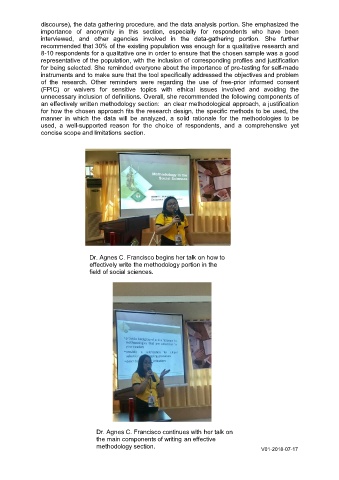Page 481 - Area_V_Parameter_C
P. 481
discourse), the data gathering procedure, and the data analysis portion. She emphasized the
importance of anonymity in this section, especially for respondents who have been
interviewed, and other agencies involved in the data-gathering portion. She further
recommended that 30% of the existing population was enough for a qualitative research and
8-10 respondents for a qualitative one in order to ensure that the chosen sample was a good
representative of the population, with the inclusion of corresponding profiles and justification
for being selected. She reminded everyone about the importance of pre-testing for self-made
instruments and to make sure that the tool specifically addressed the objectives and problem
of the research. Other reminders were regarding the use of free-prior informed consent
(FPIC) or waivers for sensitive topics with ethical issues involved and avoiding the
unnecessary inclusion of definitions. Overall, she recommended the following components of
an effectively written methodology section: an clear methodological approach, a justification
for how the chosen approach fits the research design, the specific methods to be used, the
manner in which the data will be analyzed, a solid rationale for the methodologies to be
used, a well-supported reason for the choice of respondents, and a comprehensive yet
concise scope and limitations section.
Dr. Agnes C. Francisco begins her talk on how to
effectively write the methodology portion in the
field of social sciences.
Dr. Agnes C. Francisco continues with her talk on
the main components of writing an effective
methodology section.
V01-2018-07-17

